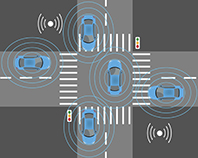Behind the Wheel at Work

Behind the Wheel at Work is an eNewsletter bringing you the latest news from the NIOSH Center for Motor Vehicle Safety.
Volume 4 Number 3 September 2019
Automated Vehicles: Part 2
Last year we provided an overview of what you need to know about automated vehicle technology in the workplace. This year, we’re talking about safety management as it relates to automated vehicles. Questions about this topic? Tweet us @NIOSH_MVSafety. Catch up on previous issues of our newsletter.

In our September 2018 issue, we talked about vehicle automation in general terms, describing the levels of automation as defined by the Society of Automotive Engineers and the potential for highly-automated vehicles to greatly reduce crashes and injuries. Building on that, we’ll focus here on what automation means for the safety of company fleets, now and in the future.
Vehicles on the market today are the safest ever. Not only are they more “crashworthy,” but they are equipped with a variety of advanced driver-assistance systems (ADAS) that have already been proven effective to reduce crashes and injuries. ADAS-equipped vehicles can have significant safety benefits for company fleets, but fleet managers and safety professionals need to be sure that their policies are updated so they can take full advantage of these life-saving technologies.
- Today’s ADAS function at automation levels 0 through 2. Although the vehicle can take over control momentarily to avoid a crash, the driver is always responsible for monitoring what’s happening on the road.
- Research has shown that many drivers don’t understand what ADAS technology can or cannot do. Here’s an example: Lane departure warning alerts the driver that the vehicle is drifting from the lane, but lane keeping assist actually acts on the warning and steers the vehicle back into its lane. The driver may not realize that the vehicle also has lane keeping assist and won’t be comfortable if this feature is activated.
- Workers may be assigned to drive new company vehicles with technology that’s considerably more advanced than what’s on their personal vehicles. Even if their personal vehicle is equipped with ADAS, the names, symbols, and operation of ADAS are not the same across all auto manufacturers.
- Adding vehicles with ADAS to your company fleet means changing your motor vehicle safety policies now to stay ahead of the curve and lay the foundation for the introduction of more highly-automated vehicles.
- True self-driving cars are not here yet. ADAS have been linked to meaningful reductions in crashes and injuries, and companies need to take advantage of what’s available now.
- Are we preparing our drivers to safely operate ADAS-equipped vehicles in our fleet? Consider this: As an employer, you would never take a worker to a machine in a factory, point out the on/off switch, and walk away.
- Have we reinforced that ADAS are there to assist the driver momentarily, and that the driver is still fully responsible for operating the vehicle?
- Have we reviewed our requirements for buying or leasing vehicles to make sure we’re getting vehicles with the most effective safety features?
- Have we changed our maintenance procedures to make sure ADAS software is updated according to the manufacturer’s specifications?
- Do our procedures call for drivers to report possible ADAS malfunctions? Do they establish consequences for tampering with or disabling ADAS?
- Have we changed our post-collision procedures to:
- Collect and review information on ADAS: Was it enabled? Did it play a role in the collision? Are there data from the vehicle that can add to the collision review?
- Include ADAS in vehicle repair policies: Does the ADAS need to be repaired or recalibrated?
Learn what automation means for workplace motor vehicle safety management:
The American Society of Safety Professionals (ASSP) has just published the Z15.3 technical report, Management Practices for the Safe Operation of Partially and Fully Automated Motor Vehicles. It’s a blueprint to help companies incorporate vehicles with ADAS into their motor vehicle safety management systems now, and to think ahead about the changes fully-automated vehicles will bring.
Hear CMVS Director Stephanie Pratt talk about automated fleet vehicles:
In this ASSP podcast, Dr. Pratt discusses the Z15.3 technical report and the importance of integrating ADAS-equipped vehicles into safety management systems.
Learn how ADAS operate:
Mycardoeswhat.org educates consumers about the operation of ADAS in engaging and interactive ways, and offer realistic viewpoints about what we can expect of automation now and in the future. It’s a great resource for workers and their families.
Learn which ADAS are the most effective:
The Insurance Institute for Highway Safety studies the effectiveness of these features by comparing the crash rates for vehicles with and without them. This fact sheet summarizes the most current evidence.
The bottom line: Companies need to update their fleet safety management policies to get the full benefits of vehicles equipped with advanced driver-assistance systems.

This icon isn’t to inform you that there’s a coffee shop at the next exit – it tracks your driving performance and lets you know when you may be tired. Learn more about Drowsiness Alert from our friends at MyCarDoesWhat.org.

If you’re an employer who buys or leases vehicles for your workers to use on business, you’ll need to consider two levels of safety: how well the vehicle protects its occupants in the event of a crash (its “crashworthiness”), and which individual safety features are most effective in preventing a crash.
First, let’s consider how well vehicles protects their occupants if there is a crash. The United States has two organizations that assign overall safety ratings based on combined results from crash tests:
- The National Highway Traffic Safety Administration (NHTSA) gives each vehicle 1 to 5 stars: safercar.gov. This webpage also has up-to-date information on vehicle recalls.
- The Insurance Institute for Highway Safety (IIHS) designates a vehicle that best protects its occupants as a Top Safety Pick or Top Safety Pick+: https://www.iihs.org/ratings. The IIHS webpage also has resources that employees can share with their families, including recommendations for the safest cars for teen drivers: https://www.iihs.org/ratings/safe-vehicles-for-teens.
Next, businesses and consumers alike can choose from a range of automated safety features available on new cars today, often referred to as advanced driver assistance systems (ADAS). As we noted in a previous issue, levels of automation range from 0 (no automation) to 5 (full automation). ADAS function at automation levels 0, 1, and 2; examples are automatic emergency braking, cross traffic alert, lane keeping assist, and adaptive cruise control. Employers face two kinds of challenges in selecting vehicles with ADAS:
- Knowing which ADAS have been shown to be effective: The IIHS analyzes crash and injury claims for all years, makes, and models of vehicles, comparing vehicles with and without each type of ADAS. This IIHS fact sheet summarizes the evidence supporting the benefits of ADAS. Keep in mind that some newer features aren’t shown because there aren’t enough cases to analyze.
- Making sure that your employees understand how the different kinds of ADAS work: 40% of those who responded to a survey by the University of Iowa said that at some point, their vehicle had behaved in a way they didn’t understand. This result led to the creation of mycardoeswhat.org in partnership with the National Safety Council. This interactive site explains how each type of ADAS works, using strategies tailored to fit people of different ages and learning styles.
The bottom line: Resources are available to help employers and consumers select the safest possible vehicles, and to help drivers understand how automated vehicle safety features work.

There are over 40 million vehicles in the U.S. under recall due to a defective Takata airbag. The National Highway Traffic Safety Administration (NHTSA) estimates that there will be 65-70 million vehicles under recall by December 2019. As these vehicles span 19 manufacturers, Takata airbags may be in some of your fleet vehicles or in your employees’ personal vehicles. The airbags, which have the potential to explode and eject sharp metal fragments if the vehicle is involved in a crash, have caused serious injury and death. This defect is associated with long-term exposure to high heat and humidity.
What can employers do?
Employers can raise awareness about this ongoing recall and protect their employees from this hazard. Company initiatives have included parking lot sweeps using a free app to identify at-risk vehicles, mailers sent to employee homes, and paid leave to employees to take their vehicle in for necessary repairs.
At a minimum, encourage your employees and fleet managers to:
- Search vehicle identification numbers (VINs) to see if they are under recall
- Contact your local vehicle dealer to get the vehicle repaired for free
- Sign up for NHTSA’s recall notification system
The bottom line: Check if your fleet’s airbags have a recall, and encourage employees to check their personal vehicles too.

What is traffic safety culture? It involves shared values and beliefs among drivers and employers that influence their traffic safety decisions. Use NIOSH’s new GIF to promote this concept.
Questions? Comments? Email kur4@cdc.gov.
Enter your email address to receive research updates, links to motor vehicle safety resources, practical tips on workplace driving, and news about upcoming events.

